
Andrew
Andrew McCarthy is an expert in all things inflation. He has a Bachelors in Economics and has been working in the finance industry for over two decades.
by Andrew | Jul 15, 2015 | Definitions
US producer prices rose for the month of June, comfortably beating analyst expectations and rising by the fastest pace in nearly three years according to data just release by the Bureau of Labor and Statistics. Surging prices for gasoline helped lift input prices across the board, and may signal the deflationary spiral which has been affecting both the consumer and producer markets for several months may be finally beginning to abate. The BLS reported producer price index for final demand increased 0.4 percent versus analyst expectation of 0.2%, and a print of 0.5% last month. The latest data builds on gains from May, and will be a welcome waypoint for those concerned about deflation taking root within the economy, although with economic tensions on the increase globally, it appears to soon to call victory in this regard.
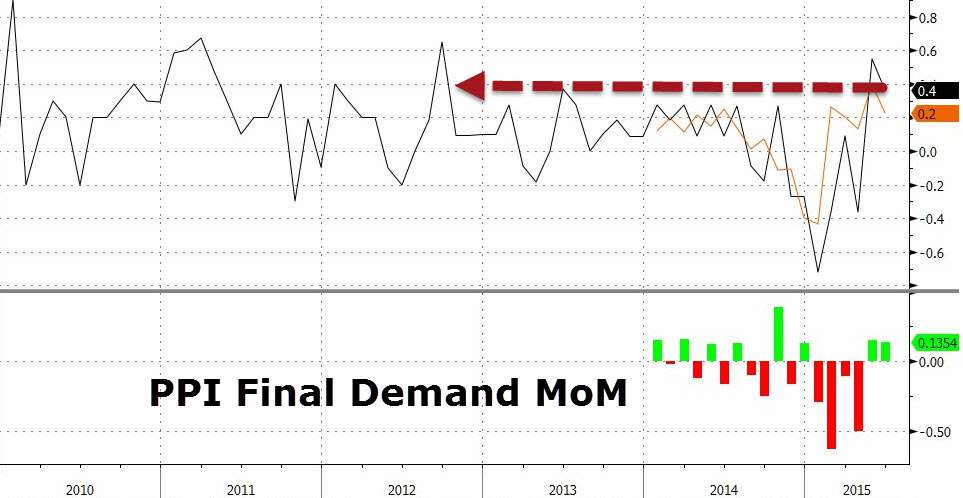

Rising Gasoline Prices Continue to Push Prices Higher
Rising gasoline prices, which rose 4.3 percent in June, accounted for nearly thirty percent of this month’s increase in prices for final demand goods. June marks the second month of surging gas prices following a 17 percent increase in May. The price of food input costs also rose, with the price of eggs in particular remaining elevated due to the bird flu outbreak which has led to a drastic cut in supply across the United States. Food prices rose 0.6 percent with wholesale eggs soaring 84.5%.
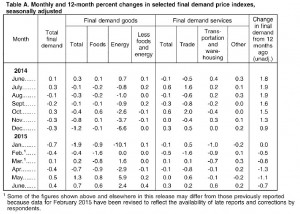
Yellen Reiterates the Fed’s Desire to Raise Rates
Elsewhere on the inflation related front, Fed Chairwoman Janet Yellen appeared before the House Financial Services Committee in Washington and reiterated the Fed’s intention to raise rates should the economy continue to “evolve as expected” in the coming months. In her statement Yellen went onto say that she expected growth to “strengthen over the remainder of this year and the unemployment rate to decline gradually”. The Fed has made no secret that any rate increase will be highly dependent on supporting data – most of which has been conflicting at best in recent months.
Yellen’s comments may fall on increasingly sceptical ears within the market, as a combination of increasingly disruptive forces worldwide begin fusing themselves into the perfect financial storm. Ongoing turmoil and potential contagion within Greece is likely to suppress European economic activity for the rest of the year as politicians lurch from one unworkable scenario to the next. China is also beginning to spark real concern amongst investors and could trigger a worldwide slowdown in the months ahead.
Canada throws in the Towel
The knock on effects from China are already being felt, with the Bank of Canada unexpectedly slashing its GDP target from 1.9% to 1.1%. Second quarter GDP in particular was axed from 1.8% to -0.5%. In what could be the first signs from a western central bank of just how bad things are becoming globally. As part of the announcement the Bank of Canada cut benchmark interest rates to 0.5% – a record low.  The BOC cited collapsing investment in the oil and gas sector as one of the main drivers of the slowdown, with investment forecast to shrink by up to 40% this year alone.
The BOC cited collapsing investment in the oil and gas sector as one of the main drivers of the slowdown, with investment forecast to shrink by up to 40% this year alone.
With Canada just a hop, skip and a jump away from the US border – the difficulty facing the Fed going forward is clear – they simply cannot raise rates when the rest of the world is attempting to ease. The results will be a full on run on most commodity and emerging market currencies.
CPI Preview for June
Consumer prices are expected to follow producer prices higher when they are announced on Friday – with rebounding food and energy costs likely to boost overall prices for the average American household. Headline inflation is forecast to increase 0.3% month on month, with core inflation expected to post a similar increase of 0.2%. Prices overall are likely to have increased 0.1% on an annualized basis, which if correct, would be an important psychological barrier to overcome as year on year data has been negative or flat throughout 2015. Core inflation will be the watched closely, with the market forecasting an increase of 1.8% on an annualized basis.
Regardless of the number on Friday, it is becoming increasingly obvious that conventional monetary policy is running out of steam and markets are not likely to be happy.
by Andrew | Jul 10, 2015 | In the news, Inflation

Rising tensions within global financial markets were the dominant concerns among Fed officials according to minutes just released from their June policy meeting, leading to yet another delay in the Fed’s widely anticipated normalization of interest rate policy. Uncertainty surrounding the future of Greece and ongoing market weakness in China triggered a cautious tone among most members, although signs of continued strength in the domestic economy, especially the labor and housing markets provided enough signs encouragement for other members to favor a rate hike in the near future.
The tug of war between these two forces will be the dominant theme for Fed watchers going forward, and signs of either beginning to dominate in the weeks ahead should offer some more concrete insight into the timing of the Fed’s next move.
In the Fed’s own words:
“Many participants emphasized that, in order to determine that the criteria for beginning policy normalization had been met, they would need additional information indicating that economic growth was strengthening, that labor market conditions were continuing to improve, and that inflation was moving back toward the Committee’s objective.”
The Fed is essentially adopting a “wait and see” approach before pulling the trigger on a rate hike which might seem premature in hindsight.
The Good – Labor Market Continues to Pick Up
On a positive note, job creation and improved employment prospects according to official figures has buoyed the Fed’s expectations for wage growth to pick up for the rest of the year. Recent consumer confidence surveys echo the Fed’s optimism, with average consumers hopeful of real wage increases in the coming months. Increased wage growth would help boost the domestic economy going forward, and the Fed will likely keep monitoring the retail sales data and employment figures closely in the weeks and months ahead for signs of a solid platform of growth emerging.
The Bad and The Ugly – Greece Weighs on Fed Outlook
Dissecting the June minutes in more detail reveals the Fed’s growing concern about the disruptive influence of overseas market turmoil arriving on domestic shores. Greece clearly weighed on policy makers minds, with particular focus on the contagion “Grexit” would cause for European financial institutions, and the domino effect this could have on US banks.
The Fed didn’t mince any words in this regard.
“[M]any participants expressed concern that a failure of Greece and its official creditors to resolve their differences could result in disruptions in financial markets in the euro area, with possible spillover effects on the United States.”
An important point to note is that the June FOMC policy meeting took place well before the most recent turmoil in Greece really flared up. It’s almost certain that the Fed would be adopting even softer language surrounding Greece given recent events. The Chinese stock market has also imploded in recent weeks, and is likely to overshadow even Greece in the near future as the biggest threat to worldwide economic stability. In recent weeks China has employed a variety of increasingly desperate measures to help slow the stock market decline, but neighboring countries in the Asia Pacific region will be looking on anxiously for signs of contagion in the near future.
Inflation continues to remain below target
On the inflation front, the minutes identified stabilizing oil prices as a potential boost to inflationary pressures within the economy in the coming months. The Fed expects increased energy costs combined with a tightening labor market to help push inflation back towards its target of 2% by the end of year – current levels are well below target.

Summing up the inflation environment and economic picture in the Fed’s own words:
“The information reviewed for the June 16-17 meeting suggested that real gross domestic product (GDP) was increasing moderately in the second quarter after edging down in the first quarter. Labor market conditions improved somewhat further in recent months. Consumer price inflation continued to run below the FOMC’s longer-run objective of 2 percent and was restrained significantly by earlier declines in energy prices and decreases in prices of non-energy imports. Survey measures of longer‑run inflation expectations remained stable, while market-based measures of inflation compensation were still low.”
In summary, it is clear there is growing sense of frustration within the Fed with regards to its inability to start normalizing rates which have been set near zero percent since the onset of the 2008 crisis. With ongoing stress in world financial markets, the Fed knows a premature hike in rates would be enough to send many nations over the edge into a full blown recession. Upcoming domestic data will be key in the coming weeks, should there be a deterioration in the domestic economic picture, then all bets for any form of rate hike this year would certainly be off.
by Andrew | Jul 10, 2015 | Definitions

The Federal Reserve is in an increasingly difficult position with regards to raising rates in 2015. The Fed has made it clear to the market that it intends to hike rates by at least 25bps by the end of the year, but with growing instability around the world, and an increasingly mixed economic picture on the domestic front, it seems increasingly likely that the Fed will need to delay its plans or risk severe market hysteria.
Consensus expectations for a move by the Fed has been softening throughout the year, analysts had predicted a stick on 25bps rate move in June which has come and gone without event. Forecasts have now shifted to September, but conviction behind such calls are waning by the day. It seems the Fed will need to stand by for another year and watch as markets around the world continue their infatuation with easy money.
The growing tension in European markets is likely to instill more caution amongst Fed officials going forward, especially given the heightened likelihood of QE being ratcheted up by the ECB. Such a policy would strengthen the dollar further, having a negative impact on both US exports and leading to deflation via cheaper imported goods from overseas.
Domestic data are also showing a less than robust economic environment which on balance, are likely to keep inflation subdued for the rest of the year and should remove any possibility of rates being hiked in 2015.
Employment remains Sluggish
On the employment front, 223K payrolls, less than the expected 233K by analysts, were added in June according to the BLS report released yesterday. The unemployment rate dropped to 5.3% from 5.4%, however participation rates crashed to a level not seen since 1977! The number of Americans no longer seeking any form of employment jumped by 640,000, the largest increase since April 2014. 93.6 million people in the United States are now completely removed the labor force, a clear sign of worsening conditions on main street.
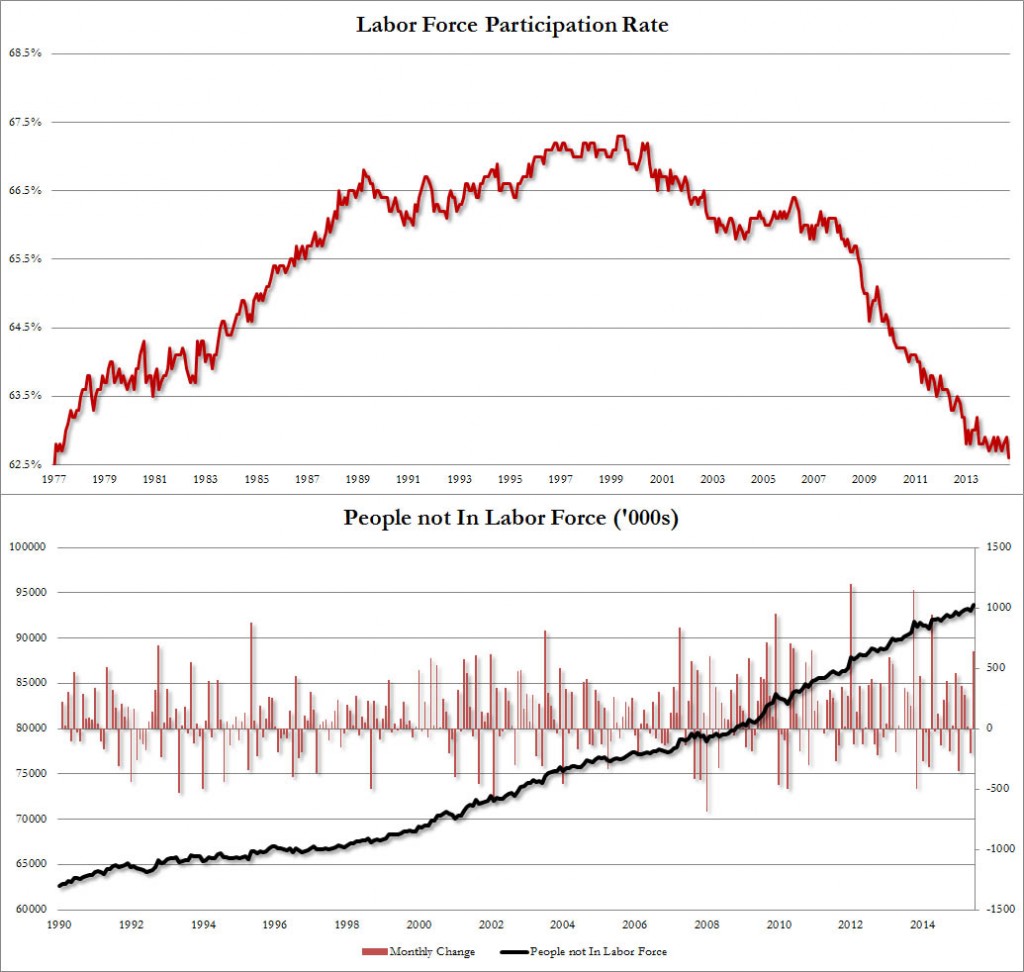
Previous numbers were also revised downwards, falling from 280,000 to 254,000 jobs and hourly earnings remained flat, which should start appearing in the consumer confidence surveys which have been setting extremely high levels in recent weeks on the expectations of higher wages going forward. The sluggish growth in employment will be an alarm bell for the Fed as they ponder the timing of their next rate cut.
Factory Orders and Exports Slide
As hinted by the Fed on numerous occasions, the strength of the US dollar is starting to adversely affect American exports and factory orders. Factory orders fell 6.3% on an annualized basis, the most since the start of the 2008 financial crisis. Manufacturing orders in particular were hard hit, falling 1 percent for the month, with previous monthly figures also revised downwards. Factory orders have now fell nine out of the previous ten months, a severe sign of weakness taking root within the sector.
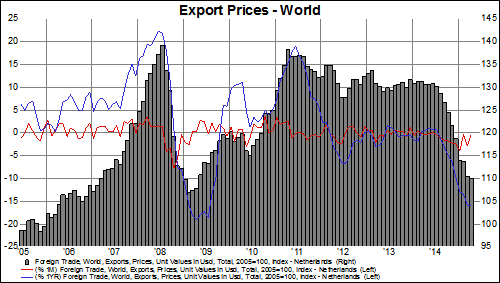
Signs of persistent deflation in export and import prices will also be a worry for policy makers following the recent data. World export prices fell by -15.8 percent on an annualized basis in April, falling once again to the lowest level since the start of the crisis. World Import prices also fell -15.1%. Prices were harder hit in developed economies, with export prices cashing -16.6 percent on an annual basis, the biggest annualized decline since 1990.
Oil Prices under pressure
Falling oil prices complete the trifecta of bearish inflation related data, with US oil rig counts rising for the first time since December, increasing fears that the supply glut which has been plaguing the industry is set to persist. Crude prices are trading below $60 per barrel on the news, and could lead to weak inflation data in the months ahead should prices persist at these levels. The recent surge in inflation in May was largely on the back of rising gasoline prices so any stabilization is likely to see the deflation trend reappear. Any reappearance of deflation within the CPI figures will be the last straw for the Fed, and any pretense for rising rates will be completely abandoned.

The Fed has made its position clear that it believes monetary policy should begin to normalize in the coming months, but with signs of economic stress present all over the world, they seem incapable of doing so. The lack of maneuverability of the Fed is a clear sign of just how crippling the current state of the global economy is currently in.
by Andrew | Jun 27, 2015 | Definitions, In the news

World markets are bracing themselves for an ugly start to the trading week following the surprise decision from Greek Prime MInister Alexis Tsipras to hold a referendum next Sunday in which Greek citizens will vote on whether to accept the latest bailout proposals from the country’s creditors. The Greek government had previously rejected the revised bailout package which included up to EUR 15.5b in funding over the next five months from the EU, IMF, and ECB on grounds that the austere conditionalities went against their mandate to govern from the Greek people. Greek finance minister Varoufakis explained the government’s decision by declaring the proposals offered “no hope” for investors and consumers, and certain aid conditions would almost certainly be recessionary for Greece in the long run. As a result, the government plan is for the Greek people to decide for themselves, but in a dramatic twist of events typical of the whole sorry saga of the Greek crisis, it seems unlikely they will have anything to vote on. The Eurogroup head Dijsselbloem has already confirmed that the current proposals will expire on Tuesday night, and will not be extended regardless of the Greek government’s request to do so. As a result, without some last minute climb down from Greece’s creditors, it is increasingly unclear what exactly the Greek people will be voting for next Sunday.
It appears all avenues of political negotiation are closing up, and following years of trial runs, it appears Greece’s moment of reckoning is imminent – both sides appear entrenched within their relative positions and the Grexit event, the seemingly never fading threat facing markets for years is upon us.
What will contagion from a Greek default look like?
Up until recently, any potential contagion from Greece has been largely ignored by the broader market. If Greece, as seems increasingly likely, is to default and leave the EU, the effects would be concentrated predominantly in world stock and bond markets. While banks in Europe and the United States have provided repeated assurances that their exposure to Greece is manageable, confidence in Wall Street models is shaky at best, and there is considerable concern that complacency has crept into consensus analysis regarding the potential impact from Grexit.

Fears over unusual market volatility are starting to show up in a variety of places, with reports of some fx brokers limiting trading activity to “close only” on Monday in an attempt to limit the expected carnage. A Greek SEC has also warned that the Athens Stock Exchange may not be able to open on Monday should ELA assistance be withdrawn by the ECB. Without the ELA several Greek banks may also be unable to open on Monday, and many Greek citizens have been rushing the ATMs since Tsipras’ surprise referendum decision last night. Lines began forming to withdraw money by 2am, and many ATMs have since run dry of cash. Bloomberg is reporting that several Greek Banks are limiting cash transactions, and further restrictions are likely to be in place for the banks that do open on Monday.
What could the longer term consequences of Grexit be?
Markets worldwide are already in a state of relative fragility and any serious fallout from Grexit could lead to some serious headline selling pressure for the world’s major markets. Should recessionary threats increase due to the upcoming event, it would seem that more QE from the world’s central banks would be on the table – in the ECB’s case, increased QE looks almost a certainty. It has been no secret throughout the whole Greek saga that a weak Euro is of great benefit to the core nations of Germany and France. Any strengthening in the Euro would be welcome to say the least. Increased QE from the ECB, which as we said, looks to be a certainty, would also severely constrain the Federal Reserve’s ability to raise rates going forward. A weakening Euro is already a default rate hike for the US via the dollar proxy. A rate hike would strengthen the dollar even further and begin to cause serious difficulties for American exports – something the Fed will no doubt be monitoring closely.
For Greece, the long term implications are less clear. There will undoubtedly be a severe amount of short term economic pain as the country adjusts to life under a new economic reality, and potentially even a new currency. Finding credibility within the world market will be difficult at first but it will eventually come back. Greece has been saddled with an increasing debt burden for too long, an exit may give the country a welcome opportunity to start again, and start building an economic future hopefully free from the unsustainable amounts of debt and uncertainty it has been carrying for too long. The Greek people certainly deserve as much.
by Andrew | Jun 18, 2015 | Definitions

May CPI numbers released by the BLS came broadly in line with expectations, with headline inflation posting an increase of 0.4% versus expectations of 0.5%. The core measure, excluding food and energy, rose 0.1% versus consensus estimates of 0.2%.
Rebounding gasoline prices were the biggest contributor to rising prices, with the gasoline index rising 10.4%. Other energy costs were mixed, and medical related costs continued to rise with the medical care commodities index rising 0.4% and the medical care services index rising 0.2%. The CPI data comes on the heels of yesterdays rate decision by the FOMC, and today’s data breathes no new significant life into our argument for rates to continue to remain fixed for the foreseeable future.
Key Highlights from the June FOMC Statement
Yesterday’s rate hike decision was a relatively tame event marketwise, although revisions in some key projections were enough to spur a moderate bout of USD weakness across the board. Delving into the statement, the Fed painted an improving economic picture, noting overall improvements since the first quarter of this year. Signs of improvement in the labor market were given particular mention.
On potential signs of growing unease with the relative strength of the US Dollar versus its peers, the Fed once again reiterated sluggish growth in US exports. While no special mention of the dollar was included in this month’s statement, currency targeting is likely to feature much more on the market’s radar going forward.
Current Conditions In the Fed’s own words:
“Information received since the Federal Open Market Committee met in April suggests that economic activity has been expanding moderately after having changed little during the first quarter. The pace of job gains picked up while the unemployment rate remained steady. On balance, a range of labor market indicators suggests that underutilization of labor resources diminished somewhat. Growth in household spending has been moderate and the housing sector has shown some improvement; however, business fixed investment and net exports stayed soft.”
With regards to inflation, the Fed reiterated its forecast for inflation to normalize towards its 2% target on the back of stabilizing energy prices and tightening labor markets in general.
“Inflation is anticipated to remain near its recent low level in the near term, but the Committee expects inflation to rise gradually toward 2 percent over the medium term as the labor market improves further and the transitory effects of earlier declines in energy and import prices dissipate.”
GDP Projections Downgraded, Unemployment Forecasts Rise
Somewhat surprisingly given the Fed’s upbeat language in its written statements from the June meeting, are the negative forecast revisions for both GDP and unemployment going forward. GDP projections were but from 2.3%-2.7% to 1.8%-2.0% – a fairly sizeable downgrade, and perhaps a growing reflection of the real headwinds facing the economy at present. Continued stress in the energy sector, which has seen sustained layoffs in the first half of this year, is showing signs of of having a wider impact on the economy at large. The Fed’s projections reflect this new reality, with unemployment forecasts for 2015 raised from 5.0%-5.2% to 5.2%-5.3%.
FOMC Members increase dovish stance
Revisions in the Fed’s quantitative forecasts were also backed up by a softening stance in the “dot” surveys of where each member expects the Fed Funds rate to be over the next two years. While the survey is conclusive that FOMC members expect a rate hike at some point this year, the magnitude of the rise is less clear. The overall drop from 1.875% to 1.625% in expectations for the Fed Funds rate in 2016 in many ways highlights the dwindling conviction affecting many FOMC members with regards to the extent of the “upcoming” rate hikes.
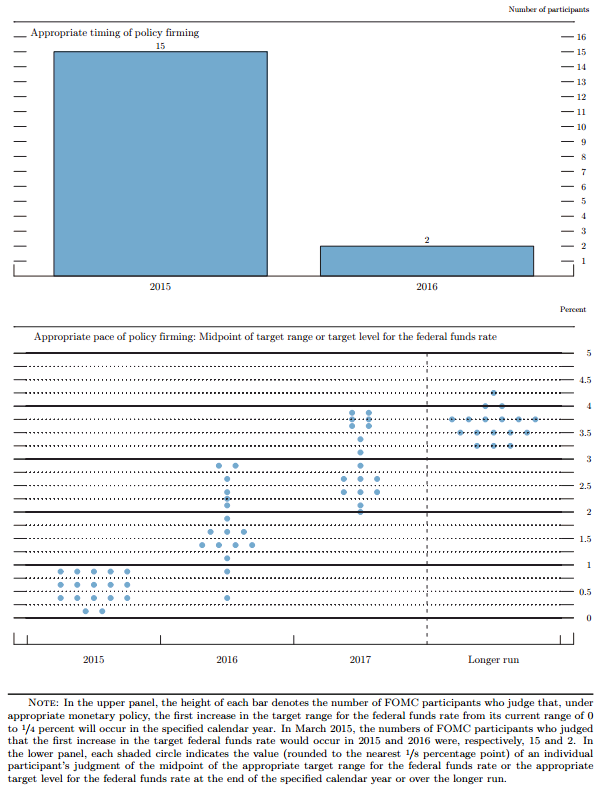
In summary, inflation is starting to show signs of stabilizing, with the deflationary month on month trends eradicated for the time being. While not evident in this month’s release, increased input costs on the producer front are likely to stoke higher inflation going forward. Medical inflation is an increasingly worrying trend, and is likely to hurt average Americans in a big way in the near future.
 The BOC cited collapsing investment in the oil and gas sector as one of the main drivers of the slowdown, with investment forecast to shrink by up to 40% this year alone.
The BOC cited collapsing investment in the oil and gas sector as one of the main drivers of the slowdown, with investment forecast to shrink by up to 40% this year alone. 














